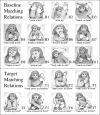Do infants show generalized imitation of gestures?
- PMID: 17345952
- PMCID: PMC1790876
- DOI: 10.1901/jeab.2007.11-06
Do infants show generalized imitation of gestures?
Abstract
Two experiments were conducted to investigate generalized imitation of manual gestures in 1- to 2-year-old infants. In Experiment 1, 6 infants were first trained four baseline matching relations (e.g., when instructed "Do this", to raise their arms after they saw the experimenter do so). Next, four novel gestures that the infants did not match in probe trials were selected as target behaviors during generalized imitation Test 1; models of these gestures were presented on unreinforced matching trials interspersed with intermittently reinforced baseline matching trials. None of the infants matched the target behaviors. To ensure that these behaviors were in the infants' motor skills repertoires, the infants were next trained to produce them, at least once, under stimulus control that did not include an antecedent model of the target behavior. In repeat generalized imitation trials (Test 2), the infants again failed to match the target behaviors. Five infants (3 from Experiment 1) participated in Experiment 2, which was identical to Experiment 1 except that, following generalized imitation Test 1, the motor-skills training was implemented to a higher criterion (21 responses per target behavior), and in a multiple-baseline, across-target-behaviors procedure. In the final generalized imitation test, 1 infant matched one, and another infant matched two target behaviors; the remaining 17 target behaviors still were not matched. The results did not provide convincing evidence of generalized imitation, even though baseline matching was well maintained and the target behaviors were in the infants' motor skills repertoires, raising the question of what are the conditions that reliably give rise to generalized imitation.
Figures





Similar articles
-
Determinants of imitation of hand-to-body gestures in 2- and 3-year-old children.J Exp Anal Behav. 2008 Mar;89(2):183-207. doi: 10.1901/jeab.2008.89-183. J Exp Anal Behav. 2008. PMID: 18422018 Free PMC article.
-
Do infants show generalized imitation of gestures? II. The effects of skills training and multiple exemplar matching training.J Exp Anal Behav. 2009 May;91(3):355-76. doi: 10.1901/jeab.2009.91-355. J Exp Anal Behav. 2009. PMID: 19949493 Free PMC article.
-
Generalized vocal imitation in infants.J Exp Child Psychol. 1991 Apr;51(2):267-79. doi: 10.1016/0022-0965(91)90036-r. J Exp Child Psychol. 1991. PMID: 2033363
-
The effect of prior practice on memory reactivation and generalization.Child Dev. 2003 Nov-Dec;74(6):1615-27. doi: 10.1046/j.1467-8624.2003.00627.x. Child Dev. 2003. PMID: 14669885 Clinical Trial.
-
Imitation in infancy: a critical review.Adv Child Dev Behav. 1989;22:271-98. doi: 10.1016/s0065-2407(08)60417-6. Adv Child Dev Behav. 1989. PMID: 2688378 Review. No abstract available.
Cited by
-
Determinants of imitation of hand-to-body gestures in 2- and 3-year-old children.J Exp Anal Behav. 2008 Mar;89(2):183-207. doi: 10.1901/jeab.2008.89-183. J Exp Anal Behav. 2008. PMID: 18422018 Free PMC article.
-
The Journal of the Experimental Analysis of Behavior at zero, fifty, and one hundred.J Exp Anal Behav. 2008 Jan;89(1):111-8. doi: 10.1901/jeab.2008.89-111. J Exp Anal Behav. 2008. PMID: 18338678 Free PMC article.
-
The impact of body-part-naming training on the accuracy of imitative performances in 2- to 3-year-old children.J Exp Anal Behav. 2011 Nov;96(3):291-315. doi: 10.1901/jeab.2011.96-291. J Exp Anal Behav. 2011. PMID: 22084492 Free PMC article.
-
The role of atomic repertoires in complex behavior.Behav Anal. 2012 Spring;35(1):59-73. doi: 10.1007/BF03392266. Behav Anal. 2012. PMID: 22942536 Free PMC article.
-
Naming and categorization in young children: v. manual sign training.J Exp Anal Behav. 2007 May;87(3):367-81. doi: 10.1901/jeab.2007.52-06. J Exp Anal Behav. 2007. PMID: 17575902 Free PMC article.
References
-
- Abravanel E, Levan-Goldschmidt E, Stevenson M.B. Action imitation: The early phase of infancy. Child Development. 1976;47:1032–1044. - PubMed
-
- Adamson L.B, Frick J.E. The still face: A history of a shared experimental paradigm. Infancy. 2003;4:451–473.
-
- Baer D.M, Deguchi H. Generalized imitation from a radical-behavioral view-point. In: Reiss S, Bootzin R, editors. Theoretical issues in behavior therapy. New York: Academic Press; 1985. pp. 179–217.
-
- Baer D.M, Sherman J.A. Reinforcement control of generalized imitation in young children. Journal of Experimental Child Psychology. 1964;1:37–49.
Publication types
MeSH terms
LinkOut - more resources
Full Text Sources
Medical

